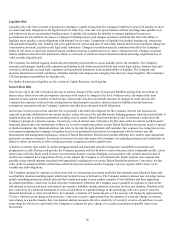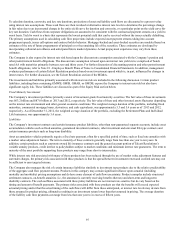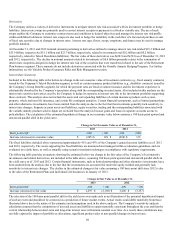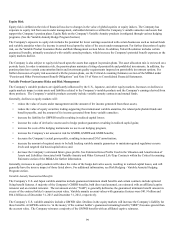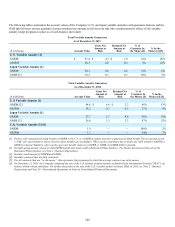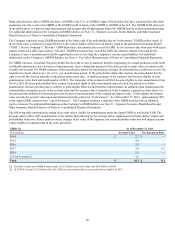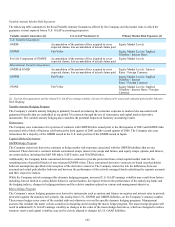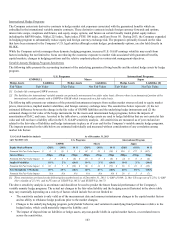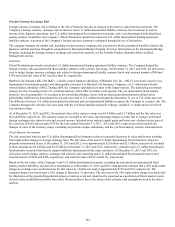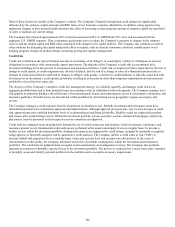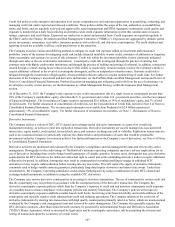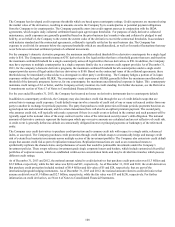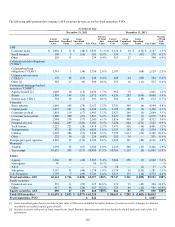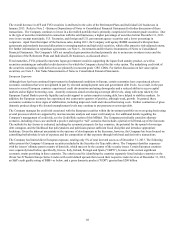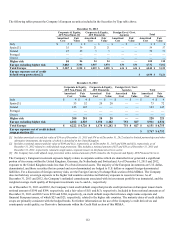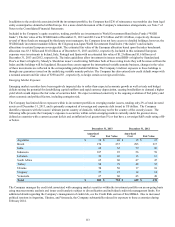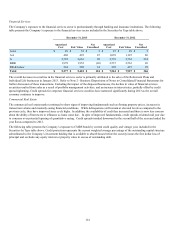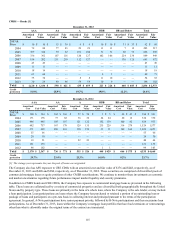The Hartford 2013 Annual Report Download - page 106
Download and view the complete annual report
Please find page 106 of the 2013 The Hartford annual report below. You can navigate through the pages in the report by either clicking on the pages listed below, or by using the keyword search tool below to find specific information within the annual report.106
Most of these factors are outside of the Company’s control. The Company’s financial strength and credit ratings are significantly
influenced by the statutory surplus amounts and RBC ratios of our insurance company subsidiaries. In addition, rating agencies may
implement changes to their internal models that have the effect of increasing or decreasing the amount of statutory capital we must hold
in order to maintain our current ratings.
The Company has reinsured approximately 20% of its risk associated with U.S. GMWB and 76% of its risk associated with the
aggregate U.S. GMDB exposure. These reinsurance agreements serve to reduce the Company’s exposure to changes in the statutory
reserves and the related capital and RBC ratios associated with changes in the capital markets. The Company also continues to explore
other solutions for mitigating the capital market risk effect on surplus, such as external reinsurance solutions, modifications to our
hedging program, changes in product design, increasing pricing and expense management.
Credit Risk
Credit risk is defined as the risk of financial loss due to uncertainty of an obligor’s or counterparty’s ability or willingness to meet its
obligations in accordance with contractually agreed upon terms. The majority of the Company’s credit risk is concentrated in its
investment holdings but is also present in reinsurance and insurance portfolios. Credit risk is comprised of three major factors: the risk of
change in credit quality, or credit migration risk; the risk of default; and the risk of a change in value of a financial instrument due to
changes in credit spread that are unrelated to changes in obligor credit quality. A decline in creditworthiness is typically associated with
an increase in an investment’s credit spread, potentially resulting in an increase in other-than-temporary impairments and an increased
probability of a realized loss upon sale.
The objective of the Company’s enterprise credit risk management strategy is to identify, quantify, and manage credit risk on an
aggregate portfolio basis and to limit potential losses in accordance with an established credit risk appetite. The Company manages to its
risk appetite by primarily holding a diversified mix of investment grade issuers and counterparties across its investment, reinsurance, and
insurance portfolios. Potential losses are also limited within portfolios by diversifying across geographic regions, asset types, and
sectors.
The Company manages a credit exposure from its inception to its maturity or sale. Both the investment and reinsurance areas have
formulated procedures for counterparty approvals and authorizations. Although approval processes may vary by area and type of credit
risk, approval processes establish minimum levels of creditworthiness and financial stability. Eligible credits are subjected to prudent
and conservative underwriting reviews. Within the investment portfolio, private securities, such as commercial mortgages, and private
placements, must be presented to their respective review committees for approval.
Credit risks are managed on an on-going basis through the use of various processes and analyses. At the investment, reinsurance, and
insurance product levels, fundamental credit analyses are performed at the issuer/counterparty level on a regular basis. To provide a
holistic review within the investment portfolio, fundamental analyses are supported by credit ratings, assigned by nationally recognized
rating agencies or internally assigned, and by quantitative credit analyses. The Company utilizes a credit value at risk ("VaR") to
measure default and migration risk on a monthly basis. Issuer and security level risk measures are also utilized. In the event of
deterioration in credit quality, the Company maintains watch lists of problem counterparties within the investment and reinsurance
portfolios. The watch lists are updated based on regular credit examinations and management reviews. The Company also performs
quarterly assessments of probable expected losses in the investment portfolio. The process is conducted on a sector basis and is intended
to promptly assess and identify potential problems in the portfolio and to recognize necessary impairments.


